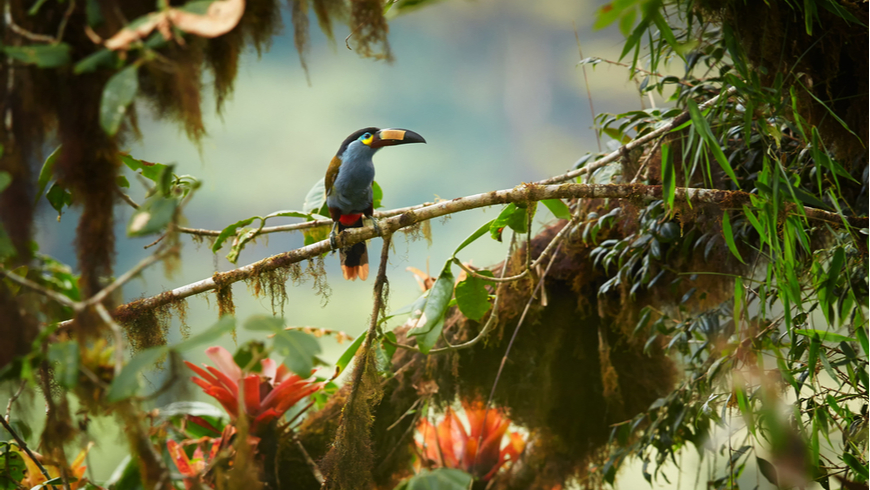(单词翻译:单击)
You heard that right –
你没听错。
These samples can be used not only for future scientific study,
这些样本不仅可以用于未来的科学研究,
but even artificial insemination to help recover an endangered population.
还能用于人工授精,挽救濒临灭绝的种群。
And while the zoo itself specializes in vertebrates and carnivores,
虽然这个动物园本身主要研究的是脊椎动物和肉食动物,
through something called the “pan-Smithsonian cryoinitiative,”
但通过所谓的“泛史密森冷冻倡议”,
Pierre and his team work with scientists at other zoos, museums, and research centers
皮埃尔和他的团队正在与其他动物园、博物馆和研究中心的科学家一起,
to preserve invertebrates, plants, and soil samples, adding microbes and fungi to a more and more complete ‘library of life.’
保护无脊椎动物、植物和土壤样本,将微生物和真菌加入到越来越完整的“生命图书馆”行列。
"So, there are specific parts of the planet that we've barely explored,
“地球上有一些地方是我们几乎完全没有探索过的,
and there are specific parts of the tree of life,
同样的,生物演化谱上也有一些地方,
like specific animal groups, that we haven't scientifically explored in the same way."
比如特定的动物种群,是我们还没有进行过科学探索的。”
So how do we know where to look next?
那么问题来了,我们怎么知道下一步该探索哪个物种呢?
Where might be most at risk, or most ripe for discoveries?
探索哪个物种风险最大,探索哪个物种的时机又最为成熟呢?
To create a roadmap that points us to where new species might be hiding,
要绘制一张能够为我们指出哪里可能隐藏着新物种的地图,
we’ll need to compile everything we know so far about where species occur,
我们需要收集我们目前掌握的,有关哪里有物种活动这一问题的所有信息,
From conservation datasets, to vintage field guides, to information collected by citizen scientists on their mobile phones.
从有关保护那些物种的所有数据集,到很久很久以前的田野考察指南,到草根科学家用手机收集的有关信息。
Enter the “Map of Life,” a flagship project at Yale’s center for biodiversity and global change that’s doing just that.
于是,耶鲁大学生物多样性和全球变化中心的旗舰项目“生命地图”应运而生了。
"What we do is compile all types of spatial and non-spatial information about species,
“我们项目的内容就是收集有关物种的各种类型的空间,非空间信息,
to get the best idea of where species occur in the world.
尽可能地了解世界上都有哪些地方存在有物种。
Our data teams can standardize millions of records so that we can really easily and quickly get an idea of,
我们的数据团队能够对这些记录做标准化处理,这样我们就能轻松并且迅速地有个概念,
'this is what information we have for this specific region.'"
比如‘这个地区我们掌握了这些信息。’”
As the name suggests, this data, taken together, creates a virtual map of life that can be used by anyone,
顾名思义,这些数据整合起来之后,就能形成一张虚拟的生命分布地图,
whether you're discovering species in your own backyard or planning a field expedition.
一张可供任何人使用的地图,无论你是在你家后院进行物种探索,还是正准备搞一次实地考察都可以用。
"We also inform UN-level decision makers, and conservation managers that are working on the ground.
“我们还通知了在当地工作的联合国级别的决策者和物种保护管理人员。
It gives an answer to people that are curious to say like, 'how can I get involved? How can I help?'
这份地图也给了那些心生好奇,想知道,‘我怎么才能参与进来?我能帮上点儿什么?’的人一个答案。
And this is showing like, 'this is what you're stewarding in your area that you live.' anywhere on the planet."
就好像在告诉你,'这就是你在你住的周围服侍的东西。’无论你身在何地都是一样。”
But whether racing to freeze tissue samples that immortalize a species
但无论是急于冷冻组织样本,让某个物种长生不老,
or drawing digital maps that point us to new discoveries,
还是绘制数字地图,为我们指明探索的新方向,
researchers agree that our best bet to preserve and document life as quickly as we can, is to act locally and think globally.
研究人员一致认为,尽快保护并记录各种生命形态的最好办法就是行动时着眼当地,思考时着眼全球。
"We built a dashboard for Peru, Ecuador, and Columbia for park managers there to figure out what species are in their park,
“我们为秘鲁、厄瓜多尔和哥伦比亚打造了一个面板,让当地的园区管理人员能够了解他们的园区里都有哪些物种,
what do we expect to be there, and also what has been actually recorded there.
我们希望那里有什么物种,以及有哪些有关当地物种的记录。
In some cases, a species only occurs in one smaller reserve, and nowhere else on the planet.
有时候,一个物种就只有某一个很小的保护区内有,世界其他任何地方都没有。
And many times the park manager doesn't know that.
但很多时候当地的园区管理人员并不知道这回事。
So it's making these really important linkages for them to be able to make decisions at a really small scale."
所以,为他们建立起这些非常重要的联系,他们就能从小处做决策。”

"We've been working extensively with Thailand, with Vietnam,
“我们与泰国、越南展开了广泛的合作,
we've been working with countries like Kuwait in the Middle East to build capacity in other countries
还与中东的科威特等国家建立了合作,帮助其他国家提高物种保护能力,
and to help countries to build their own national gene bank to make sure that they preserve their own biodiversity."
帮助他们建立自己的国家基因库,方便他们自己保护自己国家的生物多样性。”
"The regions with the most rewarding potential to have new discoveries are the tropical forests.
“最有可能取得新发现的是热带雨林地区。
They harbor most of the undescribed species on earth, amphibians, reptiles, birds, and mammals."
因为地球上大多数尚未进入人类记载的物种,如两栖动物、爬行动物、鸟类和哺乳动物等都生活在这些地区。”
So, if all we need to do is preserve our tropical forests,
那么,如果说我们只需要保护好我们的热带雨林,
recruit an army of taxonomists to explore their living treasures,
召集一批分类学家去探索生活在那里的宝藏物种,
clean out the shelves of our scientific collections to see what might be hiding in plain sight,
清理掉搁浅在我们科学收藏站那些架子上的样本,看看我们眼皮底下究竟还藏着哪些物种,
and pour more resources into preserving and processing millions of samples and digital records
然后投入更多资源来保存并处理一个又一个的样本和数字记录,
to build a library of life and a road map that points us to new discoveries,
打造一个生命(形态)图书馆和一张能够指引我们取得新发现的路线图,
how close are we to discovering all life on earth?
那我们距离发现地球上的所有生物究竟还有多远呢?
"In birds, in mammals, we have a better knowledge.
“对鸟类,哺乳类动物,我们已经有比较充分的了解了。
In amphibians and reptiles, that knowledge is not that good, but it's something at least.
对两栖动物和爬行动物的了解不是很多,但也有一定的了解。
But for invertebrates and marine organisms, that knowledge is really sparse.
但对无脊椎动物和海洋生物,我们的了解就非常非常有限了。
At the current rate of discoveries it might well take like 50 years to describe all vertebrates.
按照目前的物种发现速度,要对所有脊椎动物都做一个描述可能还需要大约50年的时间。
So the other groups, like invertebrates or marine organisms,
其他物种的话,比如无脊椎动物或海洋生物,
I would say that it will take perhaps another 100 years.
我想说,可能还需要100年的时间。
Or more."
甚至更久。”
"When you think that there are millions of species on the planet
“当你想到地球上有数以百万计的物种,
and when I tell you that we only have 18,000 in the bio repositories at the Smithsonian,
当我告诉你我们史密森博物馆的生物储存库才只有18000个物种的时候,
you can see that it's a very small proportion.
你会发现我们掌握的还只是很小很小一部分。
But when you think about it, I mean, everything grows exponentially.
当如果你仔细想想,我是说,所有的事物都是呈指数级态势发展的,
Because 100 years ago, we had no idea what cryobiology was.
毕竟,100年前,我们连“低温生物学”是个啥都还不知道。
Ten years ago, we knew that we could sequence DNA,
10年前,我们知道我们可以对DNA进行测序,
but it was a very, very long process and now it can be done in an hour for a single genome.
但那时的测序过程非常非常漫长,现在,单个基因组测序的话一个小时就能搞定了。
It's a trans-generational, multigenerational effort and I think it's pretty encouraging to know that
记录所有生物物种是一项跨世代的项目,需要一代又一代人的努力,但我觉得,
there are good chances for those efforts to be carried on,
我们的努力有很大的希望能够被传承下去,
and probably improve, and go way faster than what we can do right now."
取得进展,甚至以比我们现在的速度快得多的速度发展下去,这点还挺鼓舞人心的。”
"When you're working in biodiversity conservation,
“当你从事的是生物多样性保护工作,
it's easy to lose hope because you're just seeing we're in a mass extinction crisis.
你就很容易丧失希望,因为你会亲眼看到我们陷入了一场大规模的灭绝危机。
But we're in this age where technology can really change the landscape of how we operate, in positive ways.
但我们所处的是一个技术真真切切地能以积极的方式改变我们操作的方式。
So I have a lot of hope that it's not too late, and like now is as good a time as any to do something about it."
所以我很有信心,现在还不算太迟,现在是我们亡羊补牢最好的时机。”


